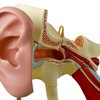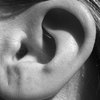Inner ear infections, also known as middle ear infections or otitis media, occur when the Eustachian tube becomes infected. The infection can be acute or chronic and is usually caused by fluid buildup in the inner ear. Ear infections are more common in children than adults.
Causes
Inner ear infections are normally associated with a cold or other respiratory illness. Fluid becomes trapped in swollen Eustachian tubes leading to infection and pain. An acute inner ear infection will come on suddenly and may leave quickly. Chronic infections persist for a month or longer with constant inflammation in the ear. Adult inner ear infections may be caused by viral or bacterial infections. The adenoids frequently swell during infection and the swelling will squeeze up into the inner ear causing pain.
Symptoms And Risks
Symptoms of inner ear infections in adults will include pain in the ears, hearing loss, a feeling of heaviness in the affected ear, headache, lightheadedness and dizziness. You may also have pus drain out of your ear.
Colds, respiratory illnesses and seasonal allergies can contribute to inner ear infections. High levels of smog or air pollution and smoke from cigarettes can also increase risk of infection.
Diagnosis
Your doctor will look inside your ear with an instrument called an otoscope. This lighted device will show any inflammation in the inner ear. A tympanometry is a test measuring eardrum movement and an acoustic reflectometry test tells your doctor how much fluid is in the ear.
Treatment
Your doctor may take a wait-and-see approach for 48 hours to see if the infection will clear up on its own. When infection does not clear, your doctor will prescribe antibiotics to kill any bacteria causing the infection. Your doctor may also recommend Advil or Motrin for pain. For chronic inner ear infections, you may be given antibiotic drops to put into your affected ear. Surgery is rare, but when needed, the infected and scarred tissue is removed and any repair is done to the eardrum.
Home Remedies
Apply warm compresses to the affected ear to sooth pain. Lie on your side with the affected ear down so that any infection may drain out of your ear. When prone to ear infections, discuss with your doctor if allergy or decongestant medications may help in lowering your risk of inner ear infections.
References
Writer Bio
Constance Barker, located in the hills of southern Ohio, is the owner and writer of several financial, credit report and travel websites. She started writing in 1999 for private clients and began creating website content in 2004. She gained expertise in home improvement after she and her husband built their home themselves.




